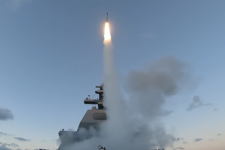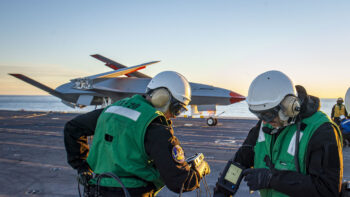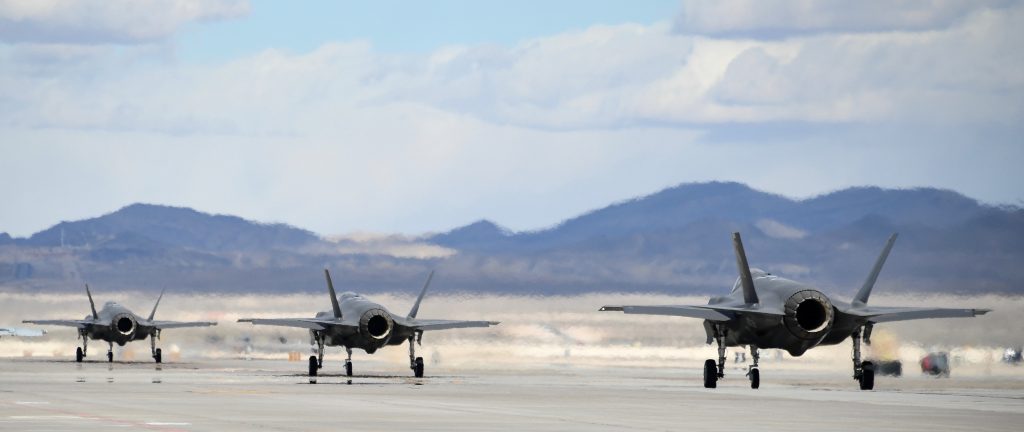
F-35As of 388th Fighter Wing’s 4th Fighter Squadron at Red Flag 2019, Nelllis Air Force Base, Feb. 6.
The Air Force needs to buy more new fighter planes. The constricted size and increasing age of the Air Force’s fighter inventory is the product of long-standing deferred investment; the 2009 decision to prematurely curtail the F-22 buy at less than half its required inventory; failure to boost F-35 production to originally planned rates; and the fact that 234 of 1970’s era F-15Cs will be hitting the end of their service lives in the next decade. Maintaining the current fighter inventory size demands that the Air Force buy at least 72 fighters per year into the 2020s. Failure to meet this requirement is not an option given the burgeoning global threat environment. With the fiscal year 2020 defense budget set for release next month, Congress will prove critical in charting a prudent path forward.
On one side of the debate, the Air Force could boost the production rate of its newest fifth-generation F-35 fighter—an aircraft imbued with stealth and information gathering, processing, and sharing capabilities that allow it to effectively execute its missions in modern threat environments and return home safely.
The other side of the debate involves a course of action already written into the 2020 budget headed to Capitol Hill. The Office of the Secretary of Defense (OSD) has influenced the Air Force to submit a budget request for a newly constructed legacy fighter—the F-15X. This is an airframe design that first flew in 1972, but is now packed full of new sub-systems.
The options of either increasing F-35 production or introducing the F-15X to the fighter force involve a variety of complex sub-issues, and viable perspectives exist for each option. In recent press engagements Acting Defense Secretary Patrick Shanahan reportedly made very disparaging remarks about the F-35 and in an effort to balance those words went on to say that it, “has a lot of opportunity for more performance.”
In contrast, airmen who are actually flying the F-35 validate that it is already a fundamental game changer. As one F-35 pilot recently explained: “What was once nearly impossible has become commonplace with the advantages brought by fifth-generation aircraft like the F-35.”
While the ultimate outcome of the debate is far from clear, Congress needs to take particular care that the Department of Defense (DOD) and the Air Force are charting an optimal path to meet the demands of the 2018 National Defense Strategy. This means modernizing U.S. airpower by procuring aircraft that can defeat rapidly advancing adversary capabilities designed to counter U.S. airpower dominance. It also means managing the broader procurement budget in a way that does not overload a jam-packed roster of critical modernization programs. Put in this context, increasing the buy-rate of the F-35 is the best choice over adding money to buy new-old F-15s.
Budget Realities
Defense leaders responding to F-15X procurement rumors have bent over backwards claiming that the issue is not about pitting the F-15X against the F-35. They fervently state they remain fully committed to the newer fifth-generation fighter. While such statements are sincere, overarching budget factors may preclude room for both a commitment to F-35 and a small fleet of new F-15s. A high national debt, increasing interest rates and growing pressure from mandatory spending accounts suggests that America may have already seen the high point of defense spending. President Trump has signaled such concern within recent months. Added to this, House Armed Services Committee Chairman Adam Smith opposes a high defense top-line and may seek reduced funding in 2020.
Depending on 2020 election results, a new administration could also significantly drop the defense budget. The net effect of these drivers would see the Air Force stuck holding a significant modernization bill with too few dollars. Offsets may take shape in the form of cancelled programs, a reduced F-35 buy rate, raided readiness accounts, or some combination of all these deleterious options. If the result is a budget shoot-out between the F-15X and F-35, the latter program would likely enter a classic programmatic death spiral—when quantity reductions drive up higher unit costs, which then drives further aircraft cuts. This is an outcome that would pose high risk for the Air Force. It would also undermine the other services and allies relying on the F-35 to modernize their respective fighter forces.
There simply is no additional room for a new program within the Air Force’s present acquisition budget. It is packed with multiple critical recapitalization priorities, including the F-35, B-21, KC-46, T-X, UH-1 replacement, new intercontinental nuclear-tipped missiles, several space priorities and cyber weapons.
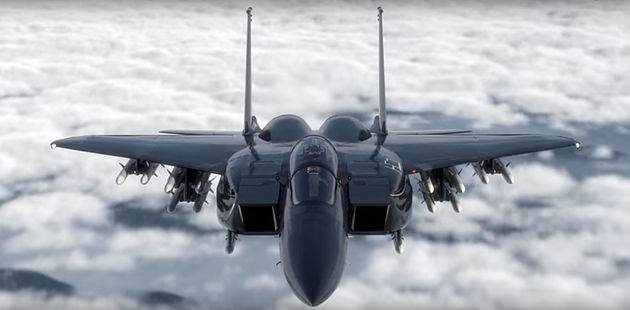
F-15
While the specific details are not publicly known about how a F-15X force building option developed between the OSD and the Air Force, adding a new aircraft procurement line to an already immense recapitalization plan will add risk across several budget years. An operationally useful inventory of F-15Xs would involve the purchase of at least 100 aircraft to yield one wing. A one-for-one recapitalization of the geriatric F-15C fleet would amount to 234 F-15Xs. Given press reports of a buy rate of eight airframes in 2020 and 20 a year into the future, the Air Force could find itself procuring F-15Xs for over a decade—the very same period when pressure on the defense budget is expected to mount.
Even though reports suggest the Air Force may have received additive money to cover F-15Xs, it is important to recognize that a deal struck with Shanahan may change with subsequent DOD leaders. History has not been kind to the Air Force in this regard, with past “guaranteed” deals falling dangerously short. When Defense Secretary Robert Gates cancelled the F-22 at less than half the Air Force requirement, he emphasized this was a low-risk decision because of the F-35:
The F-35 is 10 to 15 years newer than the F-22, carries a much larger suite of weapons … [is] less than half the total cost of the F-22, and can be produced in quantity with all the advantages produced by economies of scale – some 500 will be bought over the next five years, more than 2,400 over the life of the program…Consider that by 2020, the United States is projected to have nearly 2,500 manned combat aircraft of all kinds. Of those, nearly 1,100 will be the most advanced fifth generation F-35s and F-22s.
Gates’ optimistic predictions did not work out. Ten months away from 2020, the Air Force possesses just 186 F-22s and less than 175 F-35s. Regardless of Secretary Gates’ miscalculations, subsequent leaders had new priorities; circumstances evolved; and the F-35’s production rate significantly lags originally programmed levels. The result is a dangerous U.S. air superiority capacity and capability gap that negatively impacts combatant commands around the globe.
Unfulfilled and delayed recapitalization plans left the Air Force with several relatively small fleets that drive high sustainment costs because expenses are never efficiently amortized, and individual support enterprises are required for each aircraft type. Adding a small fleet of F-15Xs to the current fighter force mix would make this problem even worse. Although they are co-vintage in design, the F-15X does not match F-15Cs or F-15Es sub-system for sub-system. They are equipped with more modern and therefore different avionics; significant portions of their structures have evolved; and they may use different engines. A small fleet of F-22s, multiple F-15 variants that lack commonality, and a fleet of F-35s that has yet to scale is a recipe for unnecessary sustainment costs. Reducing life cycle expense requires buying large volumes of aircraft, retiring early-built models, and amortizing modernization efforts across a broad inventory.
Once the service buys the first tranche of the F-15X, it cannot stop until an operationally useful quantity is secured. Shanahan’s successor may see things differently and reject the additive budget funding to cover this program in out-year budgets. On the other hand, F-35 buys may be throttled as resources and circumstances allow without exploding other priorities. A new production line lacks such flexibility.
Aircraft Program Evolution
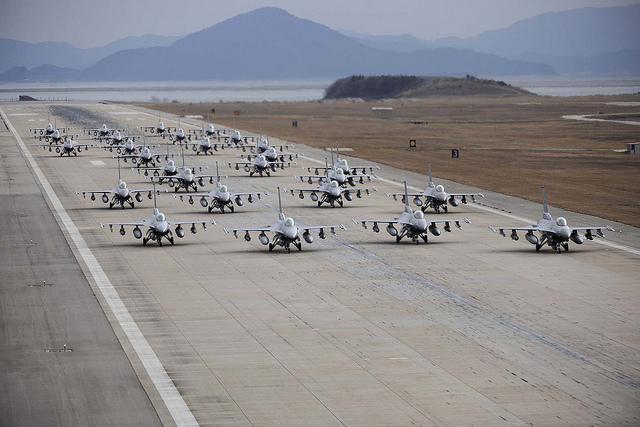
F-16s demonstrate an elephant walk at Kunsan Air Base, South Korea
As for criticisms of the F-35 program, a review of the history of military aircraft development may be insightful. Nearly every military aircraft that is now a shining example of operational success experienced a rocky path getting there. As one pilot who flew the F-16 in the opening years of its service life recalls: “Our early F-16s kept crashing. We lost four aircraft in my first 44 days at Nellis. Wing commanders were lucky to last a month. In fact, there was a macabre joke circulating that if you wanted one of the new jets, just buy an acre of land off the end of the runway and wait.” Nor was the F-16 alone when it came to early teething problems. The B-52, F-4, F-15, A-10, B-1, C-17, and many others all experienced their fair share of issues. Viewed from a historical perspective the F-35 is doing very well. This past year’s loss of an F-35B—the only crash in the program’s history—pales in comparison to other challenges in past aircraft procurement efforts.
Regarding operating cost, aircraft program expenses always come down as the technology matures and capability increases. This is a major point many F-35 total life cycle assessments ignore. Analysts too often extrapolate early program data decades into the future without factoring in realistic levels of improvement. There is a fundamental difference between the first F-35s that rolled off the line and current-build aircraft. The latter are simply more dependable thanks to standard production learning curves. Such trends will continue to bolster aircraft performance.
Given that the current F-35 fleet is so small, a significant percentage of the aircraft are early construction examples and are skewing the data. A far more accurate assessment would involve looking at jets past the first few production lots. Nor is this just an F-35 problem. This also skews program data for fleets like the F-22, which should suggest caution when critics cite F-22 data as a justification for their F-35 skepticism. There is a reason why the Air Force does not operate any early build F-15s or F-16s—they diverted those jets to roles like training and test and retired these aircraft altogether when newer versions became available. The Air Force needs to relearn these lessons, as does Congress when it executes its oversight role.
Information Age Warfare
The imperative for the F-35 also ties to capabilities not found in the F-15X. Looking to the future, success in the air domain will increasingly rely on a pilot’s ability to gather data, assimilate it into actionable information, and collaborate real-time with other actors in the region to ensure the right set of capabilities are brought to bear at the most opportune time and place. This concept is not revolutionary—military strategists have been talking about this imperative for centuries. What is new is the scale and scope of what technology now allows us to actualize. Just like smartphones redefined what it means to communicate and access information in the modern age, so too are fifth-generation aircraft transforming air combat. Their ability to gather data, process it into decision quality information for the pilot, and collaborate across the battle space is truly game-changing. Pilots with less than a year of experience in their fifth-generation aircraft are yielding effects comparable to veteran airmen with decades of experience in fourth-generation aircraft.
For example, in the recent February 2019 Red Flag combat training exercise—the most challenging and realistic Red Flag to date—the 388th Operations Group commander, Col. Joshua Wood, relates how novice F-35 pilots were able to do what much more experienced fourth-generation fighters could not—warn them of threats and amass significantly greater kill-ratios. Here is how Colonel Wood recounted events, “My wingman was a brand new F-35A pilot, seven or eight flights out of training…He gets on the radio and tells an experienced 3,000-hour pilot in a very capable fourth-generation aircraft. ‘Hey bud, you need to turn around. You’re about to die. There’s a threat off your nose.'”
This stands in contrast to the capabilities found in older fourth-generation legacy aircraft like the F-15, F-16, and F/A-18. In these aircraft, the pilot is bombarded with multiple, disparate information streams. Rapidly harnessing these inputs amidst the pressures of combat takes years of experience and constant practice. As one Air Force pilot explains:
In fourth-generation fighters, after pilots master the operation of the airplane and subsystems, all the mission training is practicing and perfecting the management of onboard systems. This training also involves effective communication and gaining experience in building a three-dimensional picture of the battlespace. It takes years for fourth-generation pilots to become masters of these systems as they move from wingman, flight lead, four-ship flight lead, instructor pilot, and finally on to be a mission commander. Even as a highly experienced mission commander, the pilot must still manage his own onboard sensors while trying to make effective and timely battle decisions.
This process is wholly different in fifth-generation fighters. In the words of an F-22 pilot: “In fifth-generation fighters, after a pilot masters flying the airplane, most of the training focuses on engagement decision-making because the battlespace is displayed from all of the fused data collected by the aircraft systems.” The contrast between the two generations of aircraft is best explained by how much the pilot can do. According to one F-22 pilot: “our young wingmen are making tactical decisions and executing accordingly at a level that historically, in our fourth-generation fleet, we would not expect out of them until they were a seasoned flight lead, if not a mission commander or instructor pilot.” Multiple years of experience required to mature in a fourth-generation fighter is condensed into under one year by sensor integration in a fifth-generation fighter.
The F-15X is empowered by systems that have evolved far past those found in the F-15C and E. However, there are limits to aircraft evolution. Some essential elements of fifth-generation information technology must be designed into a system from day one to deliver actual fifth-generation capability. The number of sensors, their integration, presentation to the pilot, and ability to connect to other platforms in the region is an area where the F-35 excels. The difference is significant when it comes to actualizing information age warfare.
Stealth—Or The Lack Thereof
In comparing the F-35 to the F-15X, it is meaningful that the F-15X is not stealthy. The F-15X lack of stealth yields a significantly restricted set of operating parameters relative to the priority objectives outlined in the national defense strategy. Aircraft shape and factors regarding low observability and electronic emissions cannot be incorporated into the F-15X airframe. Current Russian and Chinese air defense systems were specifically designed to shoot down fourth-generation aircraft. It is noteworthy that the Air Force cancelled its Joint Surveillance and Target Attack Radar System (JSTARS) recapitalization effort based upon concerns regarding adversary defenses with Air Combat Command Commander General Mike Holmes asking: “How much of our threat environment in the future will allow us to do that?” If a stand-off platform like JSTARS is not combat survivable, then why would a non-stealthy aircraft like an F-15X—which must fly into harm’s way to achieve priority missions where fighter force capacity is needed—be a sensible choice?
Those seeking budget efficiencies by buying older non-stealthy aircraft designs fail to understand that they will need more aircraft to meet mission objectives. The F-15X will require force protection to survive in high threat environments. Those force packages are comprised of specialized support aircraft to jam radars, defeat enemy fighters, and negate surface-to-air-missile systems. These additional assets in turn drive higher requirements for more pilots, more support personnel, and more support mission aircraft including air-to-air refueling tankers, more expansive basing requirements, and a proportionate boost in logistics support. Against peer threats the number of additional support aircraft required to protect the F-15X to get it to its targets dramatically increases the total cost to achieve a desired effect relative to fifth-generation aircraft.
During Desert Storm a single first-generation stealth F-117 could accomplish what it took 19 non-stealth aircraft to accomplish. Recently the Air Force Chief of Staff said, “If we had the money, those would be 72 F-35s [new fighters per year], but we’ve got to look at this from a cross-business case. The F-15 will never be the F-35. But I need an asset.” The argument is one of “I can get more F-15Xs than F-35s for equivalent dollars,” but it ignores all the other aircraft needed for force protection to enable the F-15X to accomplish an equivalent mission. The bottom line is an F-15X drives much more cost than does an F-35 to achieve a similar effect in a high-threat environment.
While the line that “fifth-generation aircraft make fourth-generation planes better” is partially accurate, there is a reverse side to that one-liner. A mixed fourth/fifth-generation aircraft force degrades the value afforded by the fifth-generation aircraft because they must spend significant time trying to keep their legacy partners alive. Given the small size of the current fifth-generation fighter force with just 186 F-22s and less than 175 F-35s in the total Air Force inventory, this sort of dilution further handicaps a force already under tremendous strain. Given that air superiority is a necessary precondition for successful military operations in all domains, this is not just an issue for the Air Force. Air superiority impacts the viability of the entirety of joint force operations. The solution demands more fifth-generation aircraft, not new fourth-generation aircraft.
The Air Force We Need
There are some specific missions where an F-15X could afford valuable service: air defense against cruise missiles by capitalizing upon its high-volume missile carriage capability; carrying outsized payloads; supporting homeland security; and high weapons payload capacity in permissive airspace. Proponents of the F-15X are quick to cite these missions and they are correct in suggesting that it would do well in such applications. However, following this line of reasoning leads to a tiered force where the F-15X would be limited to use in permissive airspace or require additional force protection aircraft if used in highly defended airspace. Understanding that the Air Force is the smallest it has ever been since its founding in 1947, a tiered force is not a practical option. Today, the Air Force does not possess the total numbers of aircraft required to meet the high threat demands of the defense strategy. That is the rationale behind Secretary of the Air Force Heather Wilson’s call for 386 operational squadrons in the “the Air Force We Need.” Today, the service lacks necessary capacity to execute current war plans as presently envisioned. These are not additive squadrons above core demand—they represent necessary capacity to meet current requirements.
At present and for the foreseeable future, the entire fifth-generation aircraft capacity of the Air Force will be stretched thin meeting mission demand. Today’s 123 combat capable F-22s and 48 combat capable F-35s cannot be in two places at once. Mission generation cycles—which involve a group of aircraft preparing to launch for a mission; another batch executing a sortie; and another set recovering back to base—rapidly parse this inventory to only a couple dozen of fifth-generation aircraft available at any given time and place.
Concurrent demand in multiple theaters or an expansive region like the Pacific further erodes the impact of these numbers. F-15Xs would be pressed forward into the fight for want of any other alternatives. This approach would put these new-build legacy aircraft at extreme risk, which is why a far more prudent response would see the Air Force bolster its fifth-generation aircraft inventories as fast as possible. China is investing in integrated air defense systems that in the Pacific will range throughout the first island chain and well toward the second. Threats will take the form of surface-to-air-missiles launched from ships and fifth-generation enemy fighters operating off aircraft carriers and manmade islands. In a Russia scenario, their current air defense systems already hold much of Europe at risk. Diverting funds to buy F-15X slows fifth-generation modernization and plays directly into peer adversary strengths.
The Air Force also lacks the resiliency to absorb significant combat losses given its small size—attrition that would grow far worse with F-15X pilots forced to fly into harm’s way for lack of fifth generation alternatives. Producing advanced combat aircraft in a surge fashion is exceedingly difficult, but the real limiting factor comes down to personnel. The pilot training pipeline is already strained to the limit trying to backfill the current peacetime fighter pilot shortfall. The pilot training system does not have enough elasticity to backfill significant wartime losses.
Complicating these factors, the Air National Guard and Air Reserve, as components of the “Total Force,” are now counted as part of the actual operational inventory for U.S. war plans. The notion of a strategic air combat reserve has disappeared over the last decade as active duty combat aircraft were shed to achieve budget efficiencies. Nor will the Air Force turn back the clock in this regard. There is not enough money to reconstitute an actual air combat reserve of airplanes and pilots. It comes down to a simple question: why would the nation provide Air National Guard and Air Force Reserve pilots a lesser chance of executing their missions and returning home safe? Strategic and moral imperatives demand providing them with the advantages afforded by fifth-generation technology.
Charting a Path Forward
When Congress evaluates the Air Force’s budget submission, it would do well to consider the advice of Sir Frederick Handley Page—a British aviation pioneer: “Nobody has ever won a war by trying to run it on the cheap. Nothing is so expensive as losing a war by saving money. If you want the cheapest possible Air Force today, it is very easy to standardize on a whole lot of aircraft that will be of no use when the war comes.” The sanctuary America enjoyed in the decades after the Cold War is over. The threats posed by Russia, China, and a host of other nations like Iran and North Korea are very real.
American vital interests are on the line and it is time to ensure force structure decisions respond now to very real existential threats. If fifth-generation technologies are not all that important—as critics often suggest—then it is illustrative that our adversaries are developing their own fifth-generation aircraft. They understand the capability of the F-22 and F-35 and they are determined to match it. While it may be too late to redress the F-22 production curtailment, leaders can learn from the mistake of its premature termination. Defense leadership must commit to technologies necessary for success against threats of the future, not the past. In the last century, the F-15 was a phenomenal airplane on a scale unequaled by any other fighter aircraft. However, it is time to turn the page and invest in the next generation of technology. That is the very reason why the F-15 was such a success. Leaders in the 1960s and 1970s invested in an air superiority aircraft that changed what it meant to fly and fight. They remained committed to that path and they fought for it because what it would provide was so important.
While officials inside the Washington D.C. beltway may continue to debate the merits of fourth versus fifth-generation air combat technology, the definitive assessments lie with those who are charged with strapping into these jets and flying into harm’s way. Those who have experienced fifth-generation technology first-hand are true believers. As one F-35 pilot recently explained: “Five to eight years ago, we would plan an entire force package of [fourth-generation] aircraft, about 20-30 aircraft, all to maybe have a slim hope of taking down a modern surface-to-air threat—just one. Now, we train to accomplish the same mission with far greater certainty using just a few F-35s, while continuing to execute a host of other taskings.” Nothing has the credibility of a flightline perspective; today’s leaders should heed such insights . Actual airmen will be the ones who will put their lives on the line. If they are given the choice of flying into harm’s way against peer-adversary threats in either an F-15X or F-35, they will answer quickly—F-35.
. Actual airmen will be the ones who will put their lives on the line. If they are given the choice of flying into harm’s way against peer-adversary threats in either an F-15X or F-35, they will answer quickly—F-35.
The Air Force cannot afford to buy anything less than the capability and capacity required to meet the objectives of the national defense strategy. This requires boosting F-35 production—not investing finite dollars in new-old aircraft designs that address yesterday’s challenges; offer marginal value; and put the broader Air Force modernization portfolio at risk. There are already too few dollars available to fund all of the Air Force’s modernization priorities—an additional aircraft line risks programmatic fratricide and the classic death spiral. There is no way the boutique merits of the F-15X are worth trading for fewer KC-46s, B-21s, T-Xs, or F-35s. America cannot afford to dilute its rate of fifth-generation air superiority modernization.
It is too late for the Air Force to amend its 2020 budget. It must now fall to Congress to exert its oversight and reverse the consequences of OSD’s pressure to insert the F-15X into the Air Force budget request. Air Force leaders are correct in articulating their need for procuring 72 new fighters per year. Today and tomorrow’s threat environment demands that those aircraft be F-35s—to build America’s asymmetric airpower advantage with a view to the future, not the past.
David Deptula is a retired lieutenant general who flew F-15 in every rank from lieutenant to lieutenant general. He is currently Dean of the Mitchell Institute for Aerospace Studies. Doug Birkey is executive director of the Mitchell Institute and an expert on military aviation.
Lockheed wins competition to build next-gen interceptor
The Missile Defense Agency recently accelerated plans to pick a winning vendor, a decision previously planned for next year.














